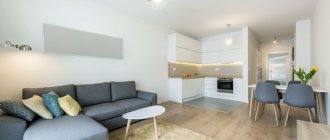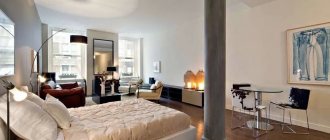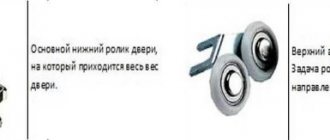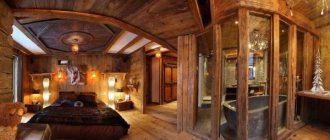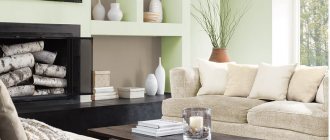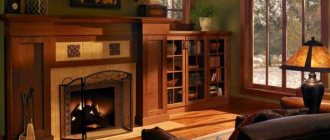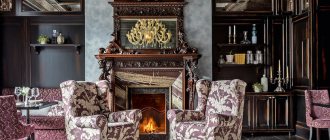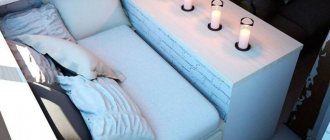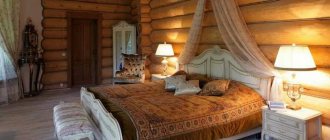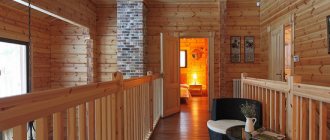About a quarter of a century ago, a fundamentally new type of wallpaper appeared in Europe - glass wallpaper. The new decorative coating quickly gained popularity all over the world. Fashion has not spared Russia either. But here consumers are faced with difficulties: well-studied wallpapering technologies either do not work at all, or work intermittently - fiberglass-based wallpaper either immediately slides off the walls or comes off after a couple of years.
Therefore, the editors of StroyGuru have prepared a material where gluing glass wallpaper for painting with your own hands is considered in detail: the characteristics of the finishing material are given, its strengths and weaknesses are considered, and a step-by-step technology for gluing it not only on walls, but also on the ceiling is given.
What is glass wallpaper?
Fiberglass wallpaper is a decorative wall covering made from special glass.
- A special material is heated to the highest temperature, and while the glass is still warm, its fibers begin to be drawn out to make yarn.
- The drawn yarn can be of different types and have its own thickness.
- The resulting material will be further used to create fabric. The front side of fiberglass wallpaper cannot be distinguished from decorative weaving, which is performed using different techniques.
Fiberglass wallpaper is perfect for gluing any surfaces, such as concrete, plastic, metal, wood, plasterboard, brick and chipboard. Before applying wallpaper, you should seal the cracks and coat the wall with a primer. Thanks to glass fibers, the service life of wallpaper is at least 15 years, and if properly cared for - 30 years. If you get tired of the color of the canvas, you can always change it with paint without harming the appearance.
Most often, this wallpaper is used for painting.
Compound
Fiberglass is made only from natural materials that do not emit harmful substances.
The composition of such wallpaper includes the following components:
- glass,
- quartz sand,
- clay,
- dolomite,
- lime,
- soda.
At the initial stage, all components must be placed in briquettes, which, when heated, will melt and stretch into threads of the required thickness. In order to weave fabric from threads, special equipment is needed. The final stage is covering the wallpaper with a special solution, which consists of modified starch.
Specifications
NameMeaning
| Life time | more than 30 years |
| Possibility of coloring | Coloring up to 20 times |
| Standard size, (m.) | 1x25; 1x50 |
| Static electricity | Does not accumulate |
| Degree of vapor permeability | High |
| Fire properties | Eat |
| Minimum density of wallpaper for wall decoration | 100 gsm m. |
Advantages and disadvantages
The advantages of this finishing coating include:
- Strength. Fiberglass wallpaper is distinguished by its high strength from other finishing coatings. They do not tear, do not scratch or become deformed. It is worth noting that the material tolerates the effects of all chemicals during wet cleaning.
- Favorable microclimate. The structure of the wallpaper consists of small loops that help water vapor move between them with ease. This “knitted product” does not attract dust and prevents the accumulation of static electricity.
- Environmental friendliness. This finishing coating consists of a special type of glass that is safe for others, and it also does not allow harmful microorganisms to multiply.
- Sustainability. The coating is not prone to mechanical damage. It does not deform when in contact with hands or in contact with furniture. If necessary, you can replace the damaged fragment using horizontal gluing.
- Easy to paste. In order to cover walls with fiberglass wallpaper, you do not need to have special skills.
- Fire safety. Resistant to high temperatures.
Disadvantages:
- Price. Depending on the image and texture, the cost of such a canvas may be inflated.
- Specialist. cloth. To carry out repair work, you will need to purchase special protective clothing. This is necessary so that when pasting the walls, microparticles of glass fiber wallpaper do not get on you, which can lead to irritation or allergies.
- Paint costs. Fiberglass wallpaper is highly absorbent, so to paint a wall you will need a large amount of paint.
Leading manufacturers
The leading brands supplying fiberglass products to the Russian market of finishing materials, from ordinary painting fiberglass to glass wallpaper with exclusive designs, include the following companies:
- Wellton (Sweden) is a leader in the production of wall coverings. Wellton produces its products in several countries. Fiberglass wallpaper is produced in Sweden and China, painting fiberglass - in Germany and Finland.
- Oscar (China) is a Chinese manufacturer that produces Wellton products under the Oscar brand, but is much cheaper than the branded counterpart.
- Vitrulan (Germany) is the founder of the production of glass wallpaper, producing them since 1931. By the way, “vitrulan” means glass fiber.
- Nortex produces glass wallpaper in the Czech Republic and China.
- Tassoglas (USA) – in addition to the USA, production facilities are located in European countries and China. Tassoglas produces a full range of classic designs, but at cheaper prices than Sweden and Germany.
- Fintex (Finland).
- BauTex(Russia-Germany).
- Bau Master (China).
- Veterman (Germany).
- Holtex (Russia).
- Vertex (Czech Republic).
- Walltex (Russia).
- Mermet (China).
- Novelio (Czech Republic-France).
- Glass Band (Russia).
Trusted manufacturers
This review is presented as an introduction to popular, proven manufacturers. Don't take it as a rating. Each of the brands has proven itself well over a long time and sells consistently high-quality glass wallpaper.
- Vitrulan. A German company founded more than 100 years ago and leading the production of glass wallpaper since 1960. It specializes in the production of a wide range of canvases and accessories necessary for gluing and painting them. All products have extensive performance qualities. The disadvantage is the abundance of fakes, so it is recommended to purchase brand products only from official representatives of the manufacturer or trusted sellers.
- Wellton and Oscar. The largest manufacturer of glass wallpaper, which emerged as a result of the merger of several production facilities from Germany, Sweden and Finland. It has a wide range of product lines, which are replenished with new collections every year. A distinctive feature of the brand is the possibility of choosing both premium and economy class products.
- X glas. Russian trademark, part of the products of the Liga Company. The brand has been known since 2003 and has established itself as a reliable and responsible manufacturer of glass wallpaper, adhesives and other construction and finishing materials. The product line is in no way inferior to imported analogues and complies with all GOSTs, SNiP, fire safety requirements and specifications developed by technologists.
Types of glass wallpaper
Smooth or Embossed
- Smooth products are essentially fiberglass canvas. Thanks to its surface, it is an ideal wallpaper for painting.
- Relief products are more porous, dense and weigh more. They stretch and deform less and are excellent for finishing surfaces.
Varieties
- I grade. They are distinguished by high quality and density, durability. The cost of a roll of glass wallpaper is quite high.
- II grade. Products of average quality with an indefinite service life. If the wallpaper is from well-known manufacturers, then the average grade will produce only non-standard canvas sizes.
- Economy class. Low quality, short service life and low density are all inherent in this type of wallpaper. However, due to their low cost, they are quite popular among consumers.
Textures and patterns
The texture of glass wallpaper can be different, the most common options are as follows.
- “Herringbone” is a pattern suitable for any interior. It is better to decorate spacious rooms with a large herringbone pattern, small-sized ones with a small pattern.
- “Rhombus” - for lovers of geometric patterns and regular lines. Great for decorating a hallway, dining room, kitchen.
- “Matting” is a product with the same relief on both sides. Glue to both vertical and horizontal surfaces. Capable of performing a reinforcing function. Often used in office decoration.
- “Cobweb” is a chaotic and abstract pattern. The painted texture is almost invisible, but does not become smooth; this property makes it an ideal ceiling design. When pasting, no adjustment to the pattern is required.
In addition to those listed above, there are wallpapers with many more patterns, including exclusive products. Today, manufacturers offer products for every taste.
Properties of fiberglass
Glass wallpaper is produced under high temperatures: up to +1200 °C.
Under their influence, glass briquettes melt and are drawn into yarn, connecting with its threads.
The fabric created using this technology has the following properties:
- high density, tensile and bending strength;
- stable rigidity;
- ability to repel moisture;
- resistance to temperatures and open fire;
- complexity of deformation;
- breathability achieved due to the mesh structure of the fiber.
Fiberglass wallpaper has a high density and the ability to repel moisture.
The listed properties make glass wallpaper a good option for rooms where it is important to maintain sterile cleanliness and safety.
Thanks to them, the canvas is used not only in the design of residential premises, but also in the construction of ships and aircraft.
How to choose glass wallpaper?
If we have already examined the main features and classifications of glass wallpaper, there is also a voluminous list of nuances that must be relied on when choosing a quality material. First of all, you should pay attention to the following factors:
- Density of the material. It is a key indicator of product quality. As mentioned earlier, natural starch can be added to the filler composition, which will help increase this value and will appear only at the gluing stage. As a result of contact with the adhesive, the starch particles will simply dissolve, which will lead to a “weak” porous structure. Unfortunately, it is impossible to identify such deception on your own, so we recommend using only trusted sellers and manufacturers, which we will talk about below.
- Relief pattern. The texture indicator can also be deliberately overestimated. The deception will only appear at the gluing stage, as a result of prolonged ironing with a roller and forcing out air bubbles. The way to avoid running into such glass wallpaper is similar to that described above: contact only suppliers with a good reputation.
- The ideal composition is a ratio of 70% glass and 30% impregnation,
- The edges of the roll should be smooth and the weaving neat.
The best glass wallpaper for the ceiling is the “cobweb” type. After painting, it forms a completely flat plane without relief patterns. In addition, it is glued without adjusting the pattern and has high reinforcing qualities.
Healthy! If it is not possible to find reviews about a specific seller of glass wallpaper, you can purchase 1 roll and verify its quality characteristics by gluing a small area yourself. Possible frauds that were listed earlier will appear at the first stage.
The selection of paint must be carried out taking into account the conditions and operating characteristics of the treated surface. Gloss or semi-gloss paint is preferred. In hallways and kitchens, it is recommended to use moisture-resistant compounds that are not prone to abrasion and destruction under the influence of aggressive detergents.
Important nuances
If the finishing is not done by hand, but by craftsmen interested in its speedy completion, they may insist that the surface can already be painted. If you do not putty the fiberglass, then you will have to apply 5-6 times more paint on it, because fiberglass has a high ability to absorb. To glue wallpaper, it is even more necessary to prime the fiberglass and apply a putty layer, because the entire texture of the glass fibers will be clearly visible, and a lot of wallpaper glue will also be used up.
In the future, a large amount of wallpaper glue can lead to damage to the wallpaper under the influence of external conditions. So the question of whether it is necessary to prime and putty is decided positively if the owner wants an excellent look and guaranteed durability of the result.
Even a non-specialist knows how to putty. The finished composition is applied with a spatula as the first layer, it is allowed to dry, then the second is applied, which is sanded after drying with a grinding machine, float or sandpaper. And only then can you paint or wallpaper.
How to properly glue to walls?
Which glue is better?
Special glue is produced for glass wallpaper that is painted. For thin coatings, it is made on the basis of high-carbohydrate starch with the addition of fungicidal, antimicrobial agents and polymers.
Thicker wall coverings require strong fastening. It is impossible to say for sure which adhesive for glass wallpaper is better, but the most commonly used for embossed wallpaper is PVA with the addition of various moisture-repellent agents that increase its resistance to soaking.
Which surface is best to glue on?
Fiberglass wallpaper must be glued to the prepared surface. To do this, it is necessary to remove the old finish and level the walls using putty; minor irregularities do not need to be removed. The walls are sanded and covered with primer. After this, the surface is ready for finishing.
Proper wall preparation
Preparation consists of alignment. Glass wallpaper requires a flat surface both on the main area and at the corners. Leveling is carried out using putty. When conducting wiring, lay the wires in advance and putty them in the grooves.
Putty
Often in old Soviet-built houses the corners were sealed with cement, which left noticeable roundings. Remove the cement completely - only in this case will you achieve even corners. If the slabs or masonry are offset relative to each other, level the angle using a square and increase the thickness of the putty to create a room with 90-degree angles.
If the room requires additional angles other than straight, foresee this fact in advance and buy special adapters that will allow you to easily complete the appearance of the room.
How long does it take for glass wallpaper to dry?
The drying speed after finishing the glass wallpaper gluing process depends directly on the amount of glue applied and its characteristics. On average, this takes 8-16 hours, but due to waterproofing features, the period may be extended.
Until it dries completely, insulate the room from excess moisture - the glue will swell, causing the canvas to fall off and require re-gluing.
How to glue glass wallpaper for painting: master class
Gluing glass wallpaper is a fairly easy task and does not require a large number of tools.
Before gluing glass wallpaper for painting, get the following tools:
- durable construction knife;
- roller;
- capacity;
- level;
- pencil;
- flat spatula.
The voiced tools represent the minimum for successful work. If you are interested in the topic of gluing wallpaper on a non-woven basis, then we advise you to turn to the appropriate material, because the process differs from gluing glass wallpaper.
If a separate area is covered with canvas, stock up on masking tape - it will prevent glue from getting on other parts of the surface.
Gluing glass wallpaper for painting is divided into 9 stages:
| 1. Mark the surface using a level and a pencil. | |
| 2. Align with horizontal height - it will create a border between two separate stripes and bring them together later. | |
| 3. After marking, start cutting using a construction knife, which allows you to cut individual fibers of the material. Before cutting glass wallpaper, measure the exact length of the piece - this will avoid overspending. Cut on a special table, but if you don’t have one, any surface that is comfortable for pressing will do. | |
| 4. Once the piece of roll is ready for gluing, apply glue to the surface using a paint roller. It is convenient to use for such purposes. | |
| 5. The adhesive layer is 2-3 mm. Check by running your finger across the surface - it will leave a noticeable groove, indicating that the adhesive layer is sufficiently thick. | |
| 6. To glue glass wallpaper before painting it, attach a piece of material and level it. Walk along one side close to a corner or another strip, and then, aligning the entire sheet with the previously applied mark, iron over the entire surface. This is done either by hand or using a special spatula. Keep in mind that air bubbles are extremely difficult to remove, so you should carefully iron and try on each sheet. | |
| 7. If the canvas goes to a certain level and there is a margin at the bottom, it is easy to trim it. To do this you will need a spatula and a knife. Using a spatula, bend back the excess piece for easier cutting. | |
| 8. After the resulting corner is thoroughly wrinkled, go along the fold line with a knife - there the fiber is the most fragile and flexible. Cover the upper part with a spatula, without going above its level. | |
| 9. After the glass wallpaper has dried, apply additional layers. Use gloss or acrylic paint. Wait until it dries, otherwise you risk moving the stripes. |
A few tips while working
When performing finishing work, some problems may arise. Some tips will help you avoid them:
- after painting, you need to let the finishing coating dry thoroughly, avoiding drafts and sunlight;
- when painting, it is advisable to use a roller with a long pile, so the depth of the relief will be better painted over (wallpaper with a light relief is painted over with a regular roller);
- It is better to paint wallpaper in natural light, without additional lighting;
- It is more convenient to paint near skirting boards or other elements with a small brush;
- Pasting is best done at a temperature of 18-25°C and humidity - approximately 79%.
Today, many people use glass wallpaper to separate rooms, creating an original atmosphere. Thanks to the safety and quality of the material, glass wallpaper is in more and more demand every day.
Features of care
Glass wallpaper does not require special care - since it withstands moisture well, it can be washed with an ordinary wet cloth, which makes the material extremely convenient for children's rooms, bathrooms and kitchens. Read the article about photo wallpaper in the interior of the kitchen, bedroom, hallway and other rooms in the apartment.
Individual species have their own recommendations. Canvases with a paper base should not be washed - the paper quickly gets wet. Almost all directions correspond to the usual directions on non-woven and paper wall coverings.
Video: How to properly stick glass wallpaper
Flaws
Some believe that the disadvantage of fiberglass wallpaper is such a property as limited textures - with an abundance of reliefs, they come down to several typical categories: diamonds, herringbone, checkerboard and the like. However, by showing imagination, this drawback can be neutralized - if you roll the main tone with a fleecy roller to fill the pores, and then roll it smooth, with a contrasting color, you will get an original decor. Even if the rooms have the same textures, this method of painting will completely change the look of the walls.
Also causing negative emotions is the difficult dismantling of fiberglass - you can tear the wallpaper off the wall only with serious physical effort and with the help of a sharp tool. They will not come away from the wall like a canvas under any circumstances, no matter what means you use: even water it with water, even moisten it with a primer. If for some this is a disadvantage, then for many it is just an advantage - with a long service life, the wallpaper should hold on as tightly as possible, and not come off at the slightest shrinkage or high humidity in the room. Here is the forum member v. pchelin from Chernogolovka is pleased with his choice. Here is his comment:
v. pchelin FORUMHOUSE user
I used it in my apartment about 6 years ago, one roll of wallpaper was a little missing, I took two, the rest was lying around for a long time. When it came time to paint the walls at the dacha, I used the rest of the wallpaper - they allowed me to hide the defects in the plaster (I’m a beginner here). Due to the width of the joints, they are practically invisible, and the texture of the walls, I don’t know how to say it correctly, is monotonous and even. After painting it looks like perfectly puttied drywall. That's what glass wallpaper is for!
Glass dust, which can form when gluing the canvas and irritate the skin, is not a disadvantage of the material, but a feature of inexpensive brands. High-quality fiberglass is soft, pleasant to the touch, nothing falls off it, speaking of decorative woven fabric.
Features of use on the ceiling
Gluing glass wallpaper is carried out according to the same principle as on walls. Self-adhesive tape will help you check the strength of old plaster on the ceiling.
- The direction starts from the window to the opposite wall.
- Glue is used only specifically for glass wallpaper; any other glue will not withstand their weight.
- The glue is applied only to the ceiling.
- You need to act sequentially, the next strip of glue is spread after the sheet of wallpaper is glued.
- The gluing is done end-to-end, with an overlap on the walls.
- The excess is cut off after drying.
Preparatory work
Wallpaper made of fiberglass or canvas can only be applied to a well-prepared wall (ceiling). If you ignore this stage of finishing, the resulting decor will be short-lived (it will quickly begin to lag), with many defects (the paint emphasizes any unevenness). Preparatory work is carried out in the following sequence:
- sockets, switches, wall lamps, various fasteners in the form of screws, nails, etc. are removed;
- old finishing is removed;
- the surface is cleaned of dirt, grease, soot;
- cracks, chips, sinks are repaired, and masonry joints are restored in the brick wall;
- walls (ceiling) are leveled. You can use plasterboard (dry plaster) or a mortar based on cement or gypsum (wet plaster);
- the final leveling of the wall (ceiling) is carried out using putty;
- The surface is primed before gluing. If for paper wallpaper the procedure can be ignored, then in the case of fiberglass trellises, applying a primer is mandatory - the wallpaper together with the paint may not withstand the glue.
In this work, it is not possible to consider the details of the preparatory work. If you have any questions, you can follow the link to the material “How to prepare walls for wallpapering?”, where everything is explained in detail.
How to paint correctly?
Which paint to choose?
For painting fiberglass coverings, water-dispersion paint is best suited. The choice is due to the absence of toxic substances, quick drying and the absence of unpleasant odors. Depending on the type of room, you can choose acrylic, styrene-butadiene or latex-based paint.
Step-by-step painting instructions
Painting glass wallpaper has a simple procedure. However, its strict adherence helps to achieve an ideal result.
- Preparing the room and tools. Cover the floor, radiators and baseboards with film or newspaper.
- The walls are primed, after which you need to wait until completely dry,
- the corners of the room are painted with a brush,
- walls are painted using a roller,
- To ensure smooth application, avoid interruptions. Paint applied to an already dried surface will be visible at the border.
- The second layer is applied after 12 hours.
Video: How to paint glass wallpaper?
Let's start painting
How to paint glass wallpaper? You can begin painting glass wallpaper only when its surface is completely dry. At least a day must pass from the time of gluing. To work you will need:
- dishes (bowl, basin) for paint;
- dye;
- fur roller or spray;
- brush.
Diluted wallpaper glue is suitable for priming the surface of the wallpaper. This way the paint will lie more evenly and you can save on its consumption. How much dry glue needs to be diluted is indicated in the instructions.
After letting the glue dry well, we proceed directly to the painting itself. A fur roller is suitable for applying paint to a general surface, and a brush will be needed for painting joints and creating patterns. The brush is also useful for painting those places where the colors blend into one another.
Some also use stencils to apply various designs . Some people prefer to work with a sprayer.
The first time the paint must be applied in two layers. At least an hour should pass between these stains. Then you can apply another layer. In general, the optimal number of layers is determined by the quality of the paint itself. However, it is important not to overdo it here, because many layers add weight to the wallpaper, and it can simply peel off.
Tip: make sure that no bubbles appear on the wall. If the wallpaper does swell, don't panic. You can simply carefully cut the middle of the bubble and smooth out the wallpaper. Paint the cut area again.
Acrylic paint for glass wallpaper gives the surface shine and resistance to abrasion. Dispersion paint makes the surface silky. If glass wallpaper has a textured surface, it is important to remember that its pattern gradually disappears when re-painted.
Manufacturers claim that glass wallpaper can be painted up to 12 times.
choose the right color :
- do not get carried away with bright shades, because soon they may get boring and begin to irritate you;
- if you want to give the room life, use bright, rich color inserts;
- choose the color of the walls based on the color of your furniture: this way you will create a harmonious combination in color;
- if the room is small, you can use stencils of small designs, because they will visually enlarge the room.
Read about what kitchen ceiling lighting should be like - find out the requirements for lighting the work area.
The necessary materials for soundproofing the ceiling are described here, and there are also instructions on how to soundproof the ceiling with your own hands.
Popular information about soundproofing partitions - read at: https://ru-remont.com/steny/peregorodki/kak-sdelat-zvukoizolyatsiyu-peregorodok.html
Tips for caring and washing wallpaper
The glass wallpaper material itself is quite durable and can withstand various cleaning methods. The method must be selected depending on the paint covering the surface.
- Non-abrasive detergents can be used to remove stains from the glass cloth surface.
- depending on the moisture resistance of the paint, you can use soft suede or a brush,
- For preventive maintenance, it is enough to remove dust with a dry soft brush.
Color solution
White ones are most often used for painting.
Colored options are used for self-cladding. Today there are a large number of colors on the market.
Are glass wallpapers harmful to health?
At the stage of the initial formation of embossed glass wallpaper, the main material was paint that was harmful to health, containing various heavy metals, which made it easy to paint the surface of the glass.
Now this statement has no basis. Today, glass wallpaper represents one of the most environmentally friendly types of wallpaper, since only sand with a high quartz content is used in their creation.
Don't hesitate when choosing similar children's wallpaper for walls for boys or girls. They are very impact-resistant, it’s not for nothing that they are called anti-vandal. This type of finish is fire-resistant, which eliminates large amounts of CO2 emissions during a fire.
Adhesive base - which one to take?
Standard glue is not suitable for fiberglass sheeting. Therefore, you will need to purchase a special composition for this type of wallpaper, for example “Oscar” or “Quelyd”. Types of glue:
- Dry. It must be diluted manually to prepare the adhesive mixture. The advantages of dry formulations are long shelf life and low weight. Disadvantages include difficulty in use due to the need to manually dissolve the mixture.
- Ready. It is a ready-made adhesive mass dissolved with water and diluted with additional additives, such as antiseptics, enhancers and additives. The strengths of the finished glue are ease of use, long-term storage, the ability to withstand repeated cycles of freezing and defrosting, and lower consumption due to the absence of excess. Disadvantages include heavy weight and high price.
- Based on PVA. This type of glue is characterized by additional tenacity and reliability. The compositions are quite moisture resistant, so they are often used in bathrooms or kitchens. Their disadvantages include uneven drying and difficulty in the gluing process.
- Dispersive. The strongest and most durable type of glue. Used when gluing heavy wallpaper, especially on the ceiling. For lightweight fabric, it is used diluted to reduce consumption. It is more expensive than standard formulations. It's hard to remove.
Fiberglass sheeting requires a special adhesive.
If possible, you should choose an adhesive composition from the same manufacturer that produces fiberglass itself.
Its characteristics are optimal for finishing, which will increase its service life and make the installation process easier.
How to remove glass wallpaper from walls?
If you decide to remove glass wallpaper from the wall in order to apply other canvases, for example, 3D space-expanding photo wallpaper, or non-woven wallpaper, then use a spatula. The main difference is the impossibility of using various means of liquefying the glue - a steam generator or ordinary water will not pass through the dense structure.
Start working from top to bottom - this way the canvases move away under their own weight. While working, follow a number of specific safety rules:
- carry out dismantling only with gloves;
- remove slowly, otherwise they will break and become unusable, making it difficult to clean the room later.
After removal, the canvas does not have to be thrown away - embossed wallpaper will be an excellent material for decorating an impromptu gazebo or otherwise decorating an area.
Suspiciously cheap
When buying glass wallpaper, you should not lose your vigilance and purchase products from trusted manufacturers. German and Swedish companies have earned this reputation. Wallpaper made by hand will fail at any time:
- even when you try to unroll the roll, it may simply crumble in your hands;
- tear when gluing;
- lose its attractive appearance not after 20, but after 2 paintings.
You should always inquire about the availability of a certificate. When it is not there or its authenticity is suspicious, you should refuse the purchase. There is no need to be fascinated by the cheapness, unless, of course, the store is running a special promotion that is accompanied by widespread notification.
It’s a shame when the deception is discovered after applying low-quality coatings to which high-quality glue was not spared. It will be almost impossible to do anything except putty and level the walls persistently and for a long time, and run to the store for new rolls.
Preference should be given to trusted manufacturers
How necessary is fiberglass putty?
People who do not have special knowledge, and especially those who move into a new building where the interior decoration must be done on their own, often wonder whether it is necessary to putty the finished fiberglass or whether it is enough to simply paint it. After cracks appear on the surface of the recently finished walls and ceiling, and tears and bubbles appear on the wallpaper, it will become clear that this was necessary. Especially when, when you try to remove warped wallpaper, a cobweb trails behind it.
If painting or wallpapering was done directly on fiberglass, the texture of the fiberglass, seams, and joints will certainly be noticeable, which in this case will remain uncovered. This will give the freshly decorated room a not very neat look.
Fiberglass for putty should be purchased quite dense, this will simply further enhance its reinforcing properties. Such material is more expensive than thinner ones, but this is not an option on which you should look for a way to save money. Repeated repairs when the thin web fails to fulfill its purpose will cost much more than the small price difference between dense and denser pressed material.
Photos of glass wallpaper in the interior
Sources
- https://desmyhome.ru/oboi/steklooboi-chto-jeto-takoe-i-kak-s-nimi-rabotat/
- https://design-homes.ru/idei-dlya-doma/steklooboi
- https://rcycle.net/steklo/steklooboi-pod-pokrasku-i-tsvetnye
- https://stroitelstvo.expert/steklooboi/
- https://m-strana.ru/design/steklooboi-v-interere/
- https://ratingstroy.ru/stroitelnye-materialy/napolnye-i-stenovye-materialy/steklooboi-ih-vidy-harakteristiki-i-naznachenie/
- https://TvoiDvor.com/oboi/kak-kleit-steklooboi/
- https://Trizio.ru/steklooboi-v-interere-212
- https://couo.ru/kvartira-i-zagorodnyj-dom/stroitelstvo-i-remont/chto-takoe-steklooboi-i-gde-ix-mozhno-ispolzovat.html
